D.K.Budakoti & Swagata Sinha Roy
The sinking of Joshimath town in the Chamoli district of Uttarakhand state made national and international news in the first week of the new year of 2023. The cracks which were visible earlier in the buildings became prominent in the first week of January, which is when it became a public concern and alerted the government machinery.
According to Joshimath Bachao Sangarsh Samiti (JBSS), they had brought the sinking matter issue many weeks before it came into the public domain. At present the district authorities have shifted the families directly affected to safer places while looking into the resettlement and rehabilitation for the families.
The JBSS has said that the Tapovan-Vishnugad Hydel Project constructed by National Thermal Power Corporation (NTPC) is directly responsible for the building cracks and the sinking of Joshimath town. The JBSS is now spearheading the protest for the ouster of the NTPC from the area and for a better deal on the resettlement and rehabilitation package. The protest and sloganeering is reminiscent of the Tapovan-Vishnugad Hydel Project which started in Reni village, located a few kilometres away from Joshimath town.
The social activists in the area along with environmentalists and geologists have been reportedly writing on the geological fragility of the area and warned against any major construction activity in the area. Most have also been quoting the 1976 Mishra committee report which clearly mentions that Joshimath was sinking and no construction be allowed in the area. Despite all this everything was going on unbated for years.
One of the major developments was to due to the snow skiing location at Auli, just above the town of Joshimath Ropeways, hotels and other constructions in and around the town came without looking into environmental concerns.
In the Joshimath catastrophe, it has been broadly stated that works related to hydroelectric power projects, highways and tourism related construction works have been the main causes of the disaster.
However, we have ignored and forgotten to look into the growth and development of the town through the mushrooming of hotels, guest houses, home stays, shops, business outlets besides residential buildings which have put in additional stress on the fragile geological slope of the town.
Was the approval of construction works within the municipal limits outside the jurisdiction of the Joshimath municipality? Do the people’s representatives in the Municipal Councils have any say in its development and functioning or is it just limited to Solid waste Management.
NTPC states that it is not due to its construction activities and the government has defended the NTPC project. The nation’s concern related to its energy security is understandable, where sufficient, affordable and consistent energy supplies are required for all its domestic, industrial, transport and strategic areas. It wants to be self-suffici
ent in the energy sector by 2047, when India celebrates its hundred years of Independence. The Himalayas are a fragile mountain range, so for the economists, Joshimath has taken its environmental toll, while for the Deep Ecologist it is a crime under the garb of development! The development dilemma will remain until we address the depravity of basic amenities for the populace and check the widening gap of social disparity.


